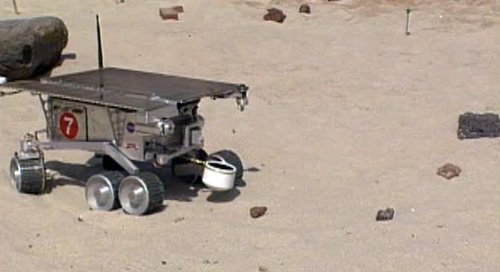
Landers view of Rocky 7 autonomously picking up 3 rocks (circa 1999).
The Planetary Dexterous Manipulators task develops new robotic system concepts and technologies for planetary surface and near-surface science. The primary applications are sample acquisition functions of the NASA Mars Surveyor Program. When integrated with future lander platforms and roving vehicles, technology products of this task will enable scientists to dexterously view, probe, freshly expose, acquire, and containerize surface and near-surface samples for in situ analysis and subsequent return to earth thus advancing knowledge of Martian geologic and biologic evolution, climate, and prevailing resources.
The major areas of technology development in PDM are:
- robot design and performance evaluation tools
- high strength-to-mass manipulators with integral sensors
- light and agile sampling effectors with active tooling
- durable all-composite structures and fabrication processes
- low mass, miniature, high-torque density ultrasonic motors
- advanced sensor-based control aglorithms for sample acquisition and instrument placement
- integration of these concepts on planetary lander and rover platforms
These innovations are potentially applicable to a wide range of Mars climates, from equatorial to near polar latitudes. The scope of R&D performed and demonstrated is ground laboratory simulated system concepts for envisioned Mars science sampling scenarios, including stand-alone evaluation of selected new components in representative Mars environmental conditions. Science requirements addressed by our work include dexterous autonomous robotic operations for viewing (micro-camera and/or imaging spectroscopy), analytic probing (point spectrometer or meteorology sensor), instrument placement (APX, NMR/EPR, M?ssbauer spectroscopy), material extraction-preparation (striated trenching, rock coring, sample abrasion and granulation) and sample exposure, acquisition, manipulation and containment (grasp-and-turn-for-view, pick-and-place, fresh rock exposure and collection). The class of robotic science operations we investigate are diverse, and will require well-coordinated advances in both robot mechanization and sensor-based robotic control for remote unstructured, uncertain environments (e.g., task-adaptive contact interactions with highly variable media, visually guided positioning, etc.).
The Mars Surveyor 1998 Lander mission science package, the Mars Volatiles and Climate Surveyor (MVACS), is based on developments in the PDM task. The PDM task is currently developing software that will be used in operations analysis for the MVACS robot arm. We are also developing autonomous sample acquisition capabilities that are targetted towards the Mars Surveyor 2003 and 2005 missions. In FY98, the PDM task demonstrated autonomous sample acquisition and science instrument placement software in collaboration with the Long Range Science Rover task, and delivered manipulator arms to the Exploration Technology Rover task. Autonomous multiple sample acquisition from a rover platform was demonstrated in 1999.
People on this Task
Hari Nayar


